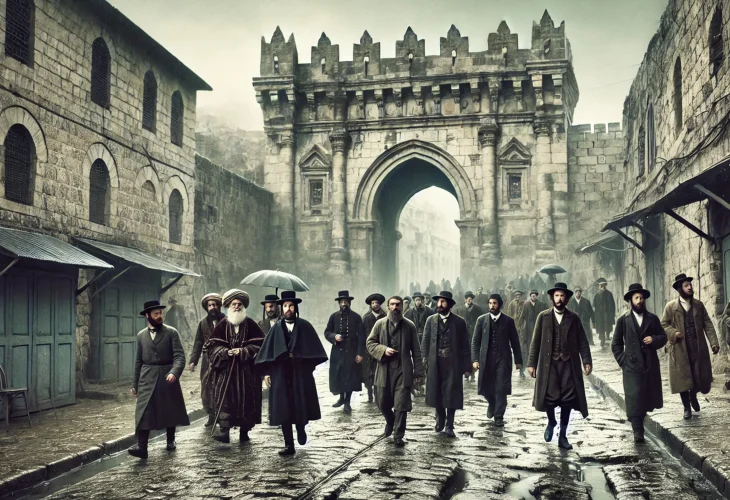The Great Heist in Jerusalem: The Fate of the King's Tomb Treasures Unveiled
The team discovered only remnants of tools and broken pottery. De Saulcy's expedition left the previous day at dusk without informing anyone.

Chanukah 1863. A group of Jews from Jerusalem, accompanied by a Turkish policeman, emerge from the Damascus Gate and head north in the pouring rain to the "Tombs of the Kings" site, where French archaeologist Felicien de Saulcy is digging. Rumor has it that de Saulcy excavated the tombs of the Kings of the House of David, plundered their treasures, and worst — desecrated these tombs, which had rested in peace for thousands of years, with plans to load the coffins and sacred bones onto donkeys to take them back to his country.
Rabbi Yosef Rivlin later describes in "The Maggid" newspaper: "Before our eyes, the bones of the greats of Israel are taken from their graves where they have rested for more than two thousand years. Woe to the eyes that see this... even one whole coffin was taken complete... and about thirty men surrounded the coffin to uncover the stone lid over it... inside the coffin they saw lying bones... disgrace and insults" (The Maggid, 6 Tevet 1863). De Saulcy excavated with the approval of the Turkish authorities, and the people of Jerusalem turned to Sir Moses Montefiore to influence a halt to the desecration of ancient graves. The order came, but too late...
The expedition uncovered only remnants of tools and broken pottery. De Saulcy's team left the day before at dusk, without notifying a soul. They loaded all the loot onto donkeys and headed toward the port of Jaffa. The Turkish policeman rode to Jaffa, but when he reached the port in the evening, he was told the French ship with the loot had sailed early that morning... The coffins are still displayed in the Louvre Museum in Paris.
The "Tombs of the Kings" site was known to the people of Jerusalem for ages. It was previously called the "Tomb of Kalba Savua." They occasionally gathered there, but never thought to enter the tomb estate, let alone loot it. In 1738, Irish clergyman and painter Richard Pococke visited the site and painted the impressive entrance: a carved stone gate 3 meters high. The painting spread in Europe, bringing interest, and later, de Saulcy's excavation and others after it.
Right after de Saulcy's heist, English explorer Tristram visited the site and was deeply impressed by its size and grandeur. He described the sophistication of the cave entrance: the stone panel opening was so cleverly concealed that even Romans, Byzantines, and treasure-loving Arabs couldn't find the entrance. Moreover, behind the door was another door that opened only from the outside. A robber entering the cave would hear a click, the door would lock behind him, and he'd remain trapped forever behind stone walls meters thick. The underground complex is approximately 35 meters by 30 meters, with an average depth of about 8 meters. Approximately 25,000 tons of rock were removed from the site, all through manual chiseling using hammer and chisel. A 9-meter-wide staircase leads to the complex, flanked by channels directing rainwater to water storage systems, possibly used as aritual bath.
Following de Saulcy's heist, Jews feared further such excavations, and a wealthy French woman named Bertha Berthnard bought the tomb site to protect it. The purchase document reads: "I, Bertha Berthnard, testify and confess... that in buying the field and the cave therein called 'The Tombs of the Kings in Jerusalem,' I have but one motive: to preserve forever this ancient and honorable memorial. I am descended from the sons of Israel. This memorial of our forefathers I wish to guard."
After her death, her heirs found it challenging to maintain the site and decided to transfer it to the French government, which had a consulate in the country, as a permanent gift under the condition of preserving the sanctity of the place and commemorating the donors' names. In 1898, Emperor Wilhelm II visited the site and posed for a famous historic photo there.
But who is truly buried there? Kalba Savua? Or the Kings of the House of David? On one of the coffins, de Saulcy found the inscription "Tzadan Malqeta," which he interpreted as referring to King Zedekiah. However, today it's not believed so. The Kings of the House of David were buried in the City of David. This site, far from the Old City, is likely the burial place of the Kings of Adiabene, also known as the Kings of Sidon. The burial in this coffin is most likely Queen Helena, who, as described by Josephus, had an elaborate burial estate built three stadia north of Jerusalem by King Monobaz, her son. This matches the location of "Coubour es-Sultan," tomb of Sultan Helena, Queen of Adiabene, who converted to Judaism and came to Jerusalem with her son Monobaz. With their great wealth, they supported Jerusalem's poor and donated special gifts to the Temple mentioned in the Mishna — including a special device for the bronze laver used to purify priests. She was well-connected with the great sages and earned an everlasting name.
If you'd like to visit the site today, coordinate with the French embassy.

